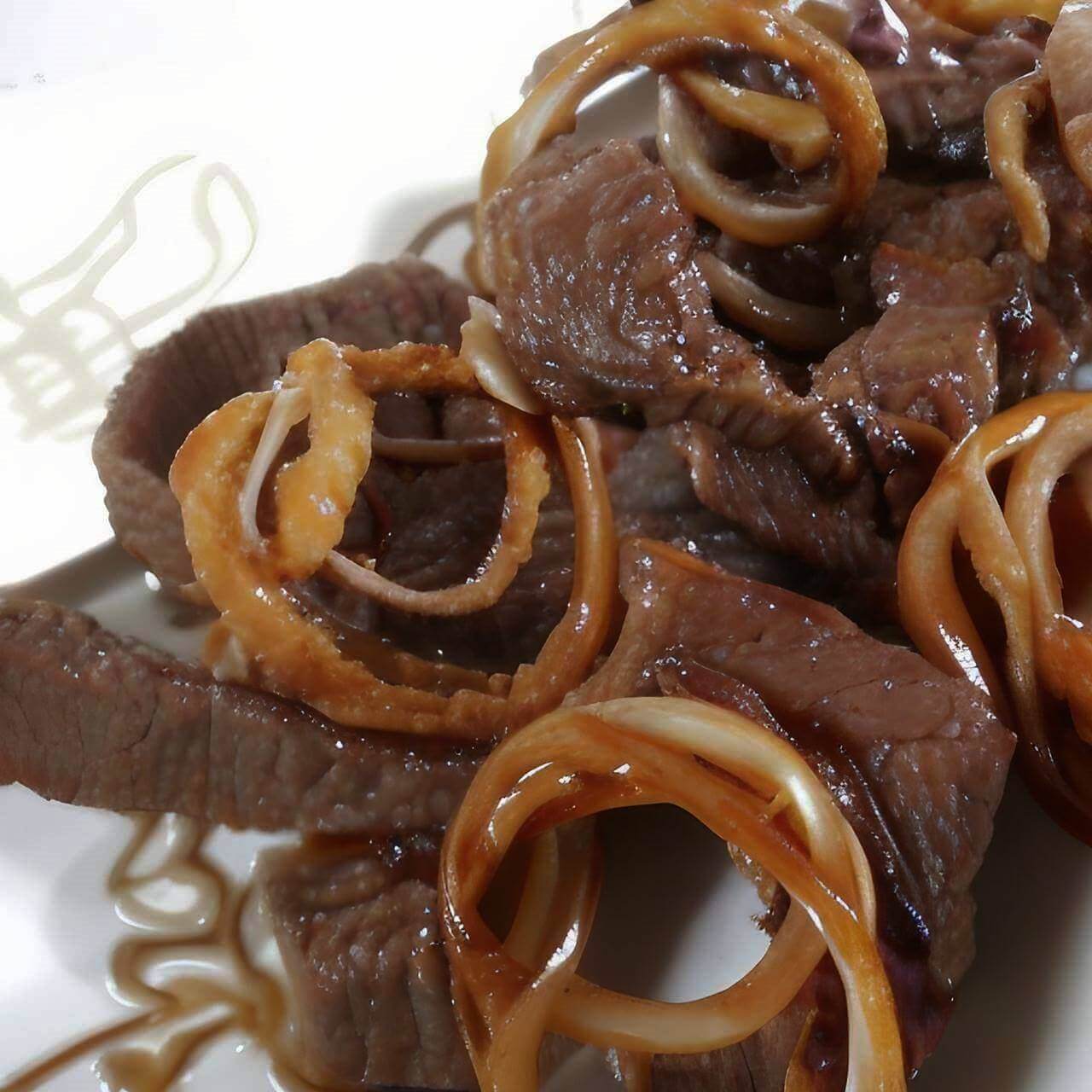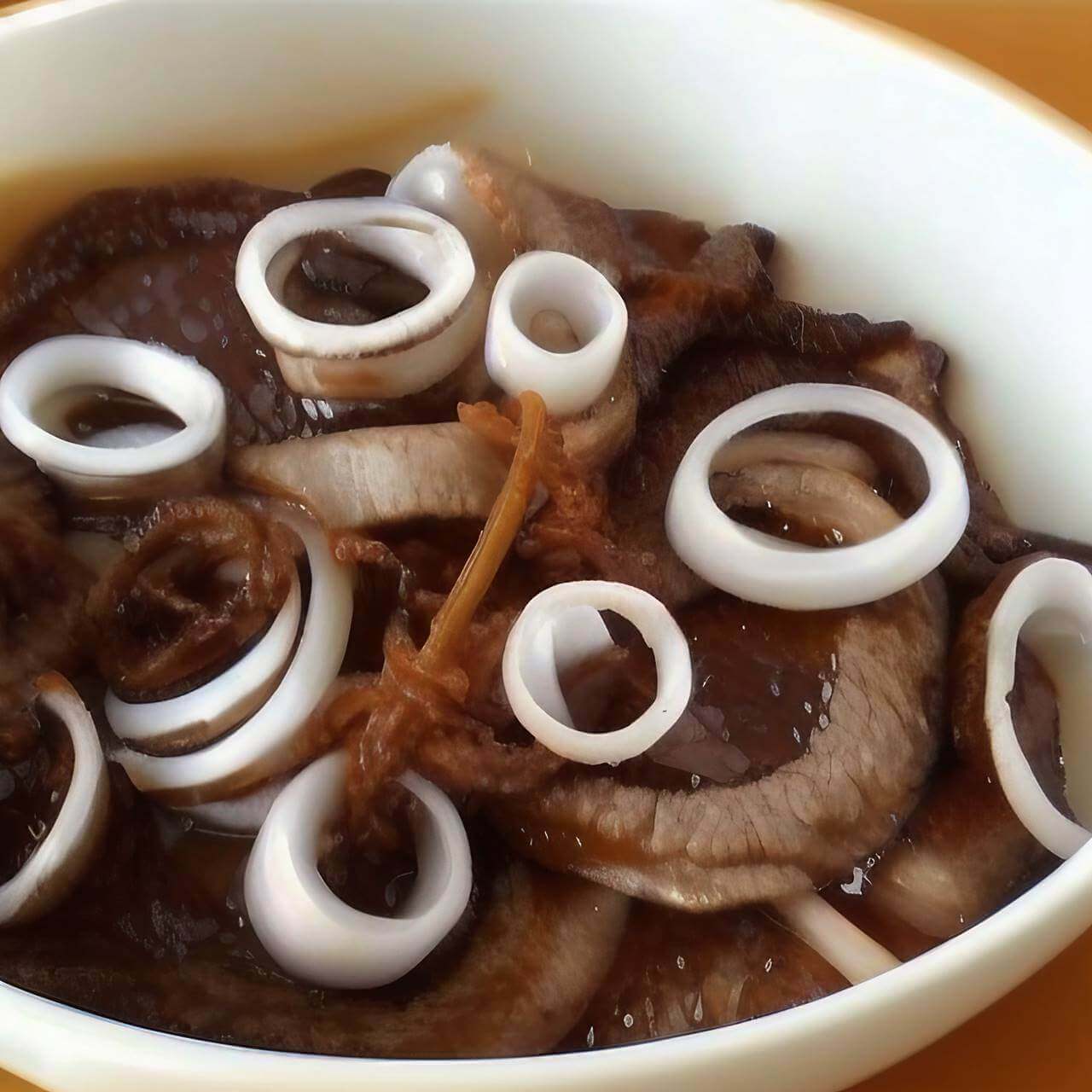Bistek Tagalog is a classic Filipino dish that only requires basic ingredients and is incredibly easy to prepare. Similar to Spanish steak and onions, Bistek comes with the bonus of no need for your preferred doneness – it’s always cooked well done! With luck, you’ll be blessed with juicy beef steaks amidst an array of crunchy onion rings swimming in savory soy-calamansi sauce. Yum! But more often than not, the sirloin becomes rock-hard and is practically inedible.
Growing up, I used to believe ‘Bistek’ was a Filipino interpretation of the English word “beefsteak”. It felt as if it had been imported from American culture into our cuisine – an attempt at creating a similar beef steak recipe based on what Americans shared during their stay in the Philippines.
Also Read: How to Cook Filipino Pinakbet
Bistek Tagalog is a scrumptious, yet effortless Filipino meal to whip up. To create it: Start by slicing the beef into thin pieces and let marinate in a mixture of calamansi juice, soy sauce, ground black pepper and salt for around 30 minutes. This process helps tenderize the meat while also imparting an extraordinary flavor! By adding salt to the marinade, you can ensure that your meat is exceptionally tender and succulent.
While you are marinating the beef, heat a skillet over medium-low flame and cook onion rings until they turn translucent. Then toss in the steak pieces along with any remaining marinade into the same pan and fry them on both sides until they become browned and crispy while all of their juices evaporate. Heat the remaining marinade juice until it thickens into a delectable sauce. Pour this heavenly concoction over stir-fried onion rings, creating a tantalizing topping for your Beef Steak dish.
If you’re a new cook looking to make something simple yet delicious for your loved ones, this bistek recipe is ideal! We’ll divide the process into three easy steps – first, prepare all of the ingredients; second, marinate the beef; and finally, fry it before boiling. This dish could not be easier or quicker to whip up! It’s as simple as that – the longer you marinate your beef, the better! However, be mindful not to exceed three hours. The optimal duration for marinating is between one and three hours; this will ensure maximum flavor absorption while keeping it succulent.

Ingredients
- Slice 750g of beef sirloin into thin, tender strips.
- Five generous tablespoons of soy sauce.
- 4 pieces calamansi or 1-piece lemon
- Add a pinch of freshly ground black pepper to accentuate the flavor.
- 3 cloves garlic minced
- For your dish, cut three yellow onions into thin circular slices.
- 4 tablespoons cooking oil
- 250 g water
- 1 pinch salt
Steps to Cook Bistek Tagalog
- For the most flavorful beef, marinate it in a mixture of soy sauce, lemon (or calamansi) juice, and freshly ground black pepper for at least one hour. To get unbeatable results that will tantalize your taste buds, let the mix sit overnight before cooking!
- Gently heat a pan of cooking oil, then sauté half of the onions until they become tender. Reserve them for later use.
- Carefully pour the marinade from the beef and set it aside. Now, on a pan where you previously crisped onions for 1 minute per side, fry up your beef. Once done cooking, take out of the pan and let rest to one side.
- Drizzle in a bit more oil if necessary and sauté the garlic alongside the fresh onions until they become tender.
- Boil the remaining marinade and water together to create a delicious dish.
- Simmer beef until it is succulent and tender, adding water as necessary. Keep the pan covered to seal in moisture for maximum flavor.
- Generously season with freshly ground black pepper and salt to taste, then top your creation off with golden pan-fried onions!
- Transfer to a serving plate and enjoy the warmth of your meal! Share with family or friends, and savor each bite!
Tips
- If you desire the perfect balance of juicy, succulent flavor and texture in your beef dishes, top round or sirloin will always be my go-to option. But if that extra bit of fat marbling is more to your liking, then definitely opt for a chuck roast!
- For that delicious recipe, you’ll need to include a handful of brown onions.
- For recipes that call for a citrus flavor, I often reach for lemons. While lemon juice provides more of an acidic kick than calamansi, it’s often easier to come by and can be used in place if necessary. However, you’ll want to adjust the amount accordingly since lemon has a stronger taste.
- For a delicious flavor, do not overlook pan-frying the beef! Before cooking, make sure you squeeze any excess marinade from the meat and pat dry. Cook on high heat for an irresistible outside crust and avoid overcrowding in your skillet.
- As you pan-fry the beef, a little of its liquid will seep out. Save this juice and add it back to your dish in combination with the marinade when braising – it’ll bring more flavor to your meal!
- Extract the flavors of onions and garlic from your marinade, then use them to tenderize the beef. Complete this masterpiece with a freshly sliced onion as a garnish for an unforgettable taste!
- Enhance the flavor of your sauce with salt after it has been reduced; as the liquid evaporates, its taste intensifies.
- Reap maximum flavor by using the same pan to finish off your dish; those browned bits left in the pan from searing the meat are an undeniably tasty treat!
- Avoid pounding your sliced beef with a mallet, as this is an ineffectual way to tenderize it. Instead, opt for low and slow braising which produces the desired texture without all that extra effort. Moreover, ensure you have your butcher cut across the grain of the meat; otherwise, it may end up stringy and tough.
- The crunch of a thick onion ring perfectly complements the succulent beef. Pursue more control over their texture by steaming them for 1-2 minutes, or longer if you prefer an even softer consistency. This method ensures they are still robust enough to hold their shape while keeping that tenderness we all crave!
- Citrus-Soy Ratio. I like a one-to-one for this recipe but unlike my strong opinion about adding sugar, feel free to adjust this to your taste. Use this ratio as a starting point and make it your own according to your preference. Calamansi has a mellower quality than the more common Eureka lemons sold in most American markets so you may find the lemon flavor more forward but this can be easily adjusted (explained below). I’ve found Meyer lemons to be the best substitute for calamansi and if you have access to them they’d be best for this recipe. Also, any soy sauce would work here but using a Filipino brand would be better if you can get it.
- Hydration: To ensure the perfect harmony of flavors and textures in your marinade, water is an essential component. My preferred proportion for citrus, soy sauce, and water usually follows a one-to-one ratio – if you’ve added half a cup of combined citrus and soy together then note that you should also mix in half a cup of Water as well. Nevertheless, don’t be afraid to experiment with various measurements according to your individual preference or taste buds!
- Onions are the star of this dish. In addition to adding them into the sauce, I love Flash-Frying onion rings and placing them atop my Bistek just before serving – their crunchiness is maintained yet softened by steam from within the covered meal!

How to Serve and Store
- Bistek Tagalog is a classic main dish for lunch and dinner, making it the perfect pairing with steaming hot rice. Give your meal an extra boost of flavor by adding some fresh onions as garnish before serving!
- Preserve leftovers in an airtight container and refrigerate for up to 3 days or freeze for up to months.
- Gently reheat in a pan over moderate heat or quickly warm up in the microwave at 2 to 3-minute intervals until completely heated.
Frequently Asked Questions
1. What does Bistek Tagalog mean?
Bistek Tagalog is a classic Filipino dish consisting of thin slices of beef marinated in a citrus-soy sauce, then pan-fried until crispy and served with onions.
2. How do you tenderize the beef?
The best way to tenderize the beef is to use a combination of marinades with flavors from onions and garlic. This will not only add flavor but also soften the meat. Additionally, braising the beef over low heat for an extended period of time can help achieve optimal tenderness.
3. How do you store leftovers?
Store leftovers in an airtight container and refrigerate for up to 3 days or freeze for up to months. Gently reheat in a pan over moderate heat or quickly warm up in the microwave at 2 to 3-minute intervals until completely heated.
4. What’s the best way to finish off a Bistek Tagalog dish?
For a finishing touch, I recommend Flash-Frying onion rings and placing them atop the Bistek just before serving. This adds an extra crunchy texture to the dish while helping to keep the beef tender and juicy. Enjoy!
5. What is the best way to adjust the flavor of a Bistek Tagalog marinade?
To adjust the flavor of this dish, start by adjusting the ratio of citrus to soy sauce. I usually recommend a one-to-one ratio but feel free to experiment with different proportions according to your taste preference. Additionally, adding some freshly ground black pepper or a little sugar to the marinade can help balance out any overly acidic flavors. Lastly, feel free to adjust the amount of water in the recipe depending on how thin and soupy you want your marinade to be.

Summary
Bistek Tagalog is a classic Filipino dish that can be enjoyed for lunch and dinner. It involves thin slices of beef marinated in a citrus-soy sauce, then pan-fried until crispy and served with onions. To ensure the perfect harmony of flavors and textures in your marinade, water is an essential component while Flash-Frying onion rings adds an extra crunch to the dish before serving.
Also, adjusting the ratio of citrus to soy sauce as well as adding some freshly ground black pepper or sugar will help balance out any overly acidic flavors according to individual preference. With these tips on hand, you’ll definitely have success creating this delicious recipe!